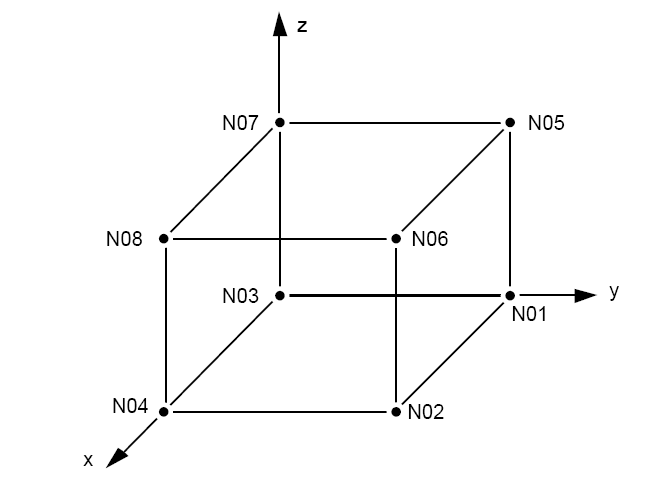3. Modeling A#
3.1. Characteristics of modeling#
3D modeling

Loading and boundary conditions are modelled by:
Dirichlet condition (keyword DDL_IMPO):
Node \(\mathrm{N04}\), \(x=y=0\),
Node \(\mathrm{N08}\), \(x\mathrm{=}y\mathrm{=}z\mathrm{=}0\),
Node \(\mathrm{N02}\), \(x=0\),
Node \(\mathrm{N06}\), \(x=0\).
Neumann condition, surface forces (keyword FORCE_FACE):
on the faces (skin elements): \((\mathrm{1,}\mathrm{5,}\mathrm{6,}2)\), \((\mathrm{1,}\mathrm{5,}\mathrm{7,}3)\),, \((\mathrm{3,}\mathrm{4,}\mathrm{8,}7)\) and \((\mathrm{4,}\mathrm{8,}\mathrm{6,}2)\).
3.2. Characteristics of the mesh#
Number of knots: 8
Number of meshes and types: 1 HEXA8, 4 QUAD4
3.3. Tested sizes and results#
3.3.1. Case of VMIS_ISOT_LINE#
Identification |
Reference type |
Reference value |
Tolerance |
\({\sigma }_{\mathrm{xx}}\) at the moment \(A\) |
“ANALYTIQUE” |
1,512E+002 |
|
\({\sigma }_{\mathrm{xy}}\) at the moment \(A\) |
“ANALYTIQUE” |
9,310E+001 |
|
\(p\) at the moment \(A\) |
“ANALYTIQUE” |
2.0547E-002 |
|
Triaxiality rate \(\mathit{TRIAX}\) at time \(A\) |
“ANALYTIQUE” |
2.2800E-001 |
|
\({\varepsilon }_{\mathrm{xx}}\) at the moment \(A\) |
“ANALYTIQUE” |
1.48297E-002 |
|
\({\varepsilon }_{\mathrm{xy}}\) at the moment \(A\) |
“ANALYTIQUE” |
1.36014E-002 |
|
\({\varepsilon }_{\mathrm{xx}}^{p}\) at the moment \(A\) |
“ANALYTIQUE” |
1.40543E-002 |
|
\({\varepsilon }_{\mathrm{xy}}^{p}\) at the moment \(A\) |
“ANALYTIQUE” |
1.29807E-002 |
|
\(p\) at the moment \(B\) |
“ANALYTIQUE” |
4,23293E-002 |
|
Triaxiality rate \(\mathit{TRIAX}\) at time \(B\) |
“ANALYTIQUE” |
3.25349E-001 |
|
\({\varepsilon }_{\mathit{xx}}\) at the moment \(B\) |
“ANALYTIQUE” |
3,5265E-002 |
|
\({\varepsilon }_{\mathit{xy}}\) at the moment \(B\) |
“ANALYTIQUE” |
2,0471E-002 |
|
\({\varepsilon }_{\mathit{xx}}^{p}\) at the moment \(B\) |
“ANALYTIQUE” |
3,3946E-002 |
|
\({\varepsilon }_{\mathit{xy}}^{p}\) at the moment \(B\) |
“ANALYTIQUE” |
2,0250E-002 |
|
as well as the charge-discharge indicators:
Identification |
Reference Type |
Value |
Tolerance |
INDIC_ENER at the moment \(A\) |
“ANALYTIQUE” |
0 |
|
INDIC_ENER at the moment \(B\) |
“ANALYTIQUE” |
3,26E-002 |
|
INDIC_SEUIL at the moment \(A\) |
“ANALYTIQUE” |
0 |
|
INDIC_SEUIL at the moment \(B\) |
“ANALYTIQUE” |
3,26E-002 |
|
INDIC_ENER at the moment \(C\) (full discharge) |
“ANALYTIQUE” |
4,69E-002 |
|
INDIC_SEUIL at time \(C\) (full discharge) |
“ANALYTIQUE” |
1.0 |
|
DERA_ELNO/RADI_Và the moment 0.1 |
“ANALYTIQUE” |
0.0 |
|
3.3.2. Case of VMIS_ECMI_LINE#
We only calculate the energies, and we compare with case VMIS_ISOT_LINE:
Identification |
Reference Type |
Value |
Tolerance |
ETOT_ELGA/TOTALE at the moment 0.1 |
“AUTRE_ASTER” |
1.16403E-03 |
|
ETOT_ELGA/TOTALE at the moment 0.9 |
“AUTRE_ASTER” |
1.84340 |
|
ETOT_ELGA/TOTALE at the moment 2.0 |
“AUTRE_ASTER” |
9.58487 |
|
ETOT_ELGA/TOTALE at the moment 3.0 |
“AUTRE_ASTER” |
9.40794 |
|
ETOT_ELNO/TOTALE at the moment 0.1 |
“AUTRE_ASTER” |
1.16403E-03 |
|
ETOT_ELNO/TOTALE at the moment 0.9 |
“AUTRE_ASTER” |
1.84340 |
|
ETOT_ELNO/TOTALE at the moment 2.0 |
“AUTRE_ASTER” |
9.58487 |
|
ETOT_ELNO/TOTALE at the moment 3.0 |
“AUTRE_ASTER” |
9.40794 |
|
ETOT_ELEM/TOTALE at the moment 0.1 |
“AUTRE_ASTER” |
1.16403E-03 |
|
ETOT_ELEM/TOTALE at the moment 0.9 |
“AUTRE_ASTER” |
1.84340 |
|
ETOT_ELEM/TOTALE at the moment 2.0 |
“AUTRE_ASTER” |
9.58487 |
|
ETOT_ELEM/TOTALE at the moment 3.0 |
“AUTRE_ASTER” |
9.40794 |
|
ETOT_NOEU/TOTALE at the moment 3.0 |
“AUTRE_ASTER” |
9.40650 |
|
3.3.3. Case of DERA_ELxx#
The discharge DCHA_V and radiality loss DCHA_R indicators are tested in mesh \(\mathit{CUBE}\):
at the first Gauss point (DERA_ELGA),
at node \({N}_{2}\) (DERA_ELNO).
We test in mesh \(\mathit{CUBE}\) at Gauss point 1:
The discharge indicator IND_DCHA, which allows you to know if the discharge remains elastic or if there would be a risk of plastification if pure kinematic work hardening was used,
Indicator VAL_DCHA which indicates the proportion of criteria output.
Identification |
Reference type |
Value |
Tolerance |
|
DERA_ELGA |
IND_DCHAà increment 10 |
“NON_REGRESSION” |
2 |
0.10% |
VAL_DCHAà increment 10 |
“NON_REGRESSION” |
0.0 |
0.001 |
|
IND_DCHAà increment 12 |
“NON_REGRESSION” |
-1 |
0.10% |
|
VAL_DCHAà increment 12 |
“NON_REGRESSION” |
0.0 |
0.001 |
|
IND_DCHAà increment 14 |
“NON_REGRESSION” |
-2 |
0.10% |
|
VAL_DCHAà increment 14 |
“NON_REGRESSION” |
1.057898 |
0.10% |
|
IND_DCHAà increment 52 |
“NON_REGRESSION” |
-2 |
0.10% |
|
VAL_DCHAà increment 52 |
“NON_REGRESSION” |
1.057898 |
0.10% |
|